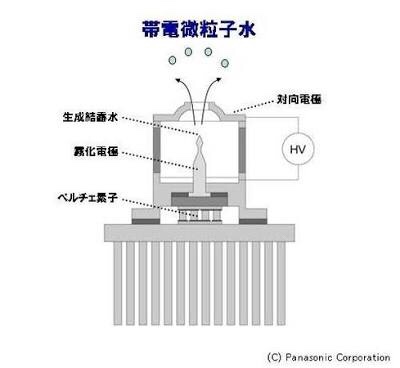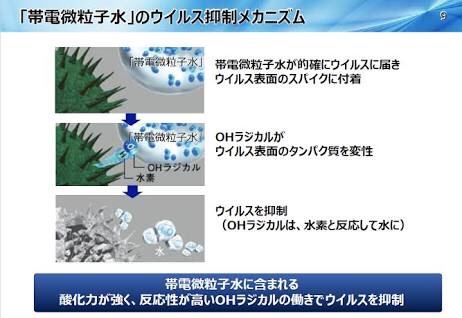

COVID-19:パナソニック、SARS-CoV-2抑制効果:帯電微粒子水(動画):
nano-sized electrostatic atomized water particle on SARS-CoV-2:
验证水中所含羟基自由基对SARS-CoV-2的抑制作用
COVID-19:
パナソニック:
大阪府立大と共同で、帯電微粒子水の新型コロナウイルス(SARS-CoV-2)に対する抑制効果を確認しました。
帯電微粒子水とは:
帯電微粒子水は、空気中の水分に高電圧を加えることで生成されます。
帯電微粒子水は、OHラジカルを含んだ微粒子イオンで、酸化力が強く反応性が高いという特長を有しています。
帯電微粒子水技術の研究:
パナソニックは、1997年に研究を開始しました。
20年以上にわたって帯電微粒子水技術の研究に取り組んできました。
人体へ悪影響を及ぼす
- 病原微生物(細菌、真菌、ウイルス)や
- アレルゲンの抑制方法、
- PM2.5含有成分の分解など、
さまざまな効果を確認してきました※1。
ウイルス・クリアランス試験:
ウイルスに関して、2012年第三者機関とウイルスクリアランス試験を実施中。
帯電微粒子水の抑制効果:
生物学的特性で、4分類したそれぞれで、抑制効果が確認できました。
未知のウイルスに対しても帯電微粒子水の抑制効果が期待できると発表しています※2。
SARS-CoV-2:抑制効果を確認
SARS-CoV-2については、新型ウイルスであることから、改めて大阪府立大学と共に試験を行いました。
結果、帯電微粒子水による抑制効果があることを確認しました。
なお、今回の確認は密閉した試験空間で実施したものであり、実使用空間における確認ではありません。
【帯電微粒子水の新型コロナウイルス(SARS-CoV-2)抑制効果 確認内容】
■方法
45 Lの試験空間において、新型コロナウイルス(SARS-CoV-2)を対象に、帯電微粒子水の曝露有無による比較実験を実施
■結果
新型コロナウイルス(SARS-CoV-2)に対し、3時間で99%以上の抑制を確認
※今回の確認は、帯電微粒子水での基礎的な研究データであり、生活空間での使用条件と異なります。
製品の性能を評価したものではありません。
■データ
- 実施機関:大阪府立大学
- 実施時期:2020年7月
- 対象:新型コロナウイルス(SARS-CoV-2)
- 装置:帯電微粒子水発生装置
- 方法:45 Lの試験空間にて、床面から15 cmの位置に帯電微粒子水発生装置を設置
ウイルス液を滴下したガーゼをシャーレに設置し、所定時間、帯電微粒子水を曝露
ウイルス感染価を測定し抑制率を算出
再現性を確認するために同じ試験を3回実施
※1. 主な発表事例
2009年5月12日:帯電微粒子水によるウイルス、細菌、農薬への効果を検証
2012年2月20日:帯電微粒子水がペットに関するアレル物質・細菌・真菌・ウイルスに抑制効果があることを検証
2014年1月16日:帯電微粒子水がPM2.5含有成分の分解と黄砂付着真菌の抑制に効果があることを検証
※2. 2012年1月26日:帯電微粒子水がウイルスクリアランス試験でウイルスに抑制効果があることを検証
(ドイツの試験機関であるCharles River Biopharmaceutical Services GmbH社と共同で検証)
プレスリリース | Panasonic Newsroom Japan
https://news.panasonic.com/press/jp/data/2020/07/jn200731-2/jn200731-2.html
Verification of inhibitory effect of hydroxyl radicals contained in water (nano-sized electrostatic atomized water particle) on novel coronavirus (SARS-CoV-2)
Osaka, Japan –
Panasonic Corporation today
announced that, in collaboration with Mayo Yasugi, Associate Professor, Department of Veterinary Science, Graduate School of Life and Environmental Sciences, Osaka Prefecture University,
it has verified the inhibitory effect of the hydroxyl radicals contained in water (nano-sized electrostatic atomized water particle) on the novel coronavirus (SARS-CoV-2).
Hydroxyl radicals contained in water
are particulate ions containing hydroxyl radicals that are generated by applying a high voltage to moisture in the air.
They are characterized by being strongly oxidative and highly reactive.
Panasonic
has been conducting research on this technology over the past 20 years since 1997,
and has verified its effectiveness in a variety of areas, including inhibiting pathogenic microorganism (bacteria, fungi, and viruses) and allergens, breaking down PM 2.5 components that have adverse effects on the human body*1.
In 2012, Panasonic
conducted a virus clearance test with a third-party organization and confirmed the effectiveness of each of the 4 categories in terms of biological characteristics.
Based on this result,
Panasonic announced that “hydroxyl radicals contained in water” technology could be expected to have a inhibitory effect on new viruses*2.
The novel coronavirus (SARS-CoV-2) of the current global pandemic is one such new type of virus,
and testing with Osaka Prefecture University
has now confirmed that the hydroxyl radicals contained in water does have an inhibitory effect on this virus.
This testing was carried out in a closed laboratory environment, and was not designed to assess its efficacy in uncontrolled living spaces.
Panasonic will continue to pursue the potential of “hydroxyl radicals contained in water” technology to address possible risks associated with air pollution such as new pathogenic microorganisms, with the aim of creating healthy environments for people around the world.
For reference :
Testing of inhibitory effect of hydroxyl radicals contained in water (nano-sized electrostatic atomized water particle) on the novel coronavirus (SARS-CoV-2)
・Overview
A comparative verification was conducted in a 45L test space containing the novel coronavirus (SARS-CoV-2) with and without exposure to hydroxyl radicals contained in water.
・Results
Over 99% of novel coronavirus (SARS-CoV-2) activity was inhibited within 3 hours.
Note: This verification was designed to generate basic research data on the effects of hydroxyl radicals contained in water on the novel coronavirus in laboratory conditions different from those found in living spaces. It was not designed to evaluate product performance.
・Methodology and data
Organization:Osaka Prefecture University
Period:July, 2020
Subject:Novel coronavirus (SARS-CoV-2)
Device:”Hydroxyl radicals contained in water” generator
Method:
– “Hydroxyl radicals contained in water” generator is installed at 15cm from the floor in the 45L test space.
– A piece of gauze inoculated with the virus solution was placed in a petri dish and exposed to ”hydroxyl radicals contained in water ” for a predetermined time.
– The virus infectious titer was measured and used to calculate the inhibition rate.
– The same test was performed 3 times to confirm reproducibility.
・Results data
Test subject Hours Inhibition rate*
SARS-CoV-2 First time 3 hours 99.7%
Second time 3 hours 99.9%
Third time 3 hours 99.9%
*Panasonic’s calculation
Headquarters News | Panasonic Newsroom Global
https://news.panasonic.com/global/press/data/2020/07/en200731-5/en200731-5.html